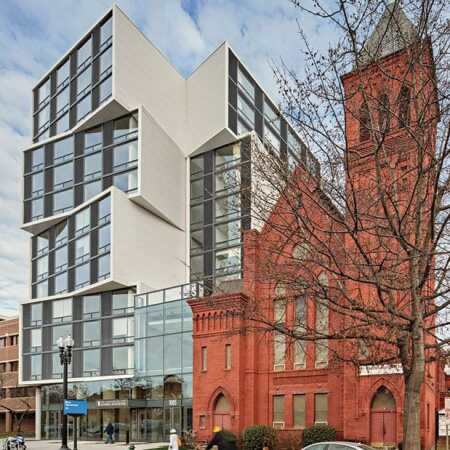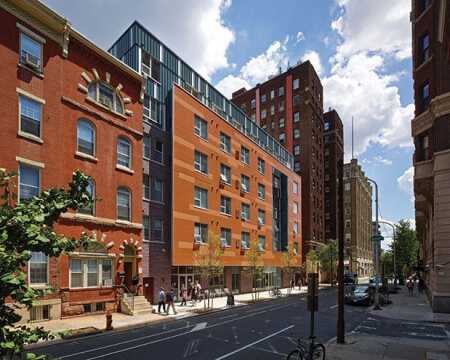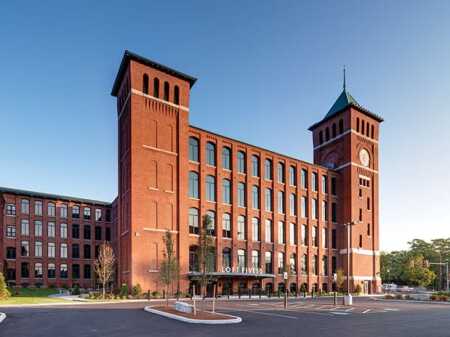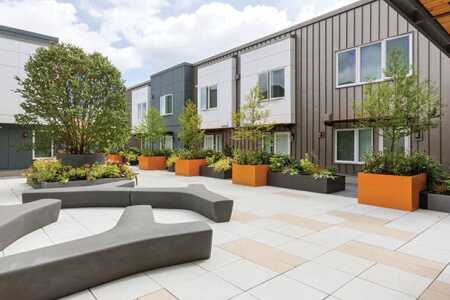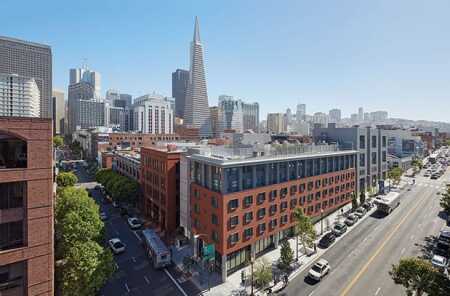High-quality design and low-cost housing are not incompatible. The gray housing projects of the past are giving way to more artful buildings with landscaped courtyards and rooftop gardens, colorful facades, and varied forms. Housing authorities and developers alike are aware of the importance of providing access to natural light, not just for individual units and communal spaces, but also for corridors. Spaces for gathering and interacting are crucial for building a sense of community, as are connections to the surrounding urban fabric.
The following ten projects—all built during the past five years—showcase a variety of design strategies that make inventive use of their project budgets. They include LGBT-friendly housing for seniors, a textile mill adapted to serve as apartments, supportive housing for military veterans and the formerly homeless, and historic cottages restored after Hurricane Katrina.
1. Boston Road Supportive Housing
The Bronx, New York City, New York
Opened in 2016, Boston Road Supportive Housing is designed to provide a sense of dignity to its residents, a mix of formerly homeless people and low-income working adults from the South Bronx. Brightly colored metal panels enliven the gray brick of the main facade. Undulating fiberboard panels in the lobby’s ceiling recall the wavy strata of schist, a type of rock found locally. The 12-story building includes 154 one-room studio apartments.
Alexander Gorlin Architects of New York City designed Boston Road for Breaking Ground, a provider of supportive and affordable housing, also based in New York City. Many of the residents are living with HIV/AIDS or have special needs and rely heavily on Medicaid, so Breaking Ground offers on-site medical and psychiatric services. Social services and administrative offices are clustered on the ground floor to encourage interaction among residents and staff, and communal areas such as a large patio, a garden, a roof terrace, a computer lab, and an exercise room foster connections among tenants.
2. CityScape at Belmar
Lakewood, Colorado
An apartment community for active seniors age 62 and older, CityScape at Belmar occupies the heart of Belmar, the urban-style mixed-use shopping center that serves as Lakewood’s pedestrian-friendly downtown. Near shops, restaurants, and medical offices, the four-story CityScape emphasizes health and wellness by including a wide staircase designed to encourage residents to skip the elevator. Amenities include a fitness facility, wellness rooms, a community garden with raised beds, and a path that leads through the site to encircle an adjacent pond. The C-shaped building surrounds a courtyard that has an outdoor kitchen, a seating area, and a fire pit.
A rain-screen panel system, a metal panel system, and cement-fiber panel siding add textural variety to the colorful exterior. Completed in 2015, CityScape has 130 one- and two-bedroom apartments, 91 of which are earmarked for households earning no more than 60 percent of the area median income (AMI); the other units rent at market rates. Studio Completiva of Denver designed CityScape for Metro West Housing Solutions, a local nonprofit provider of affordable housing.
3. Iberville Off-Site Rehabs I and II
New Orleans, Louisiana
Hurricane Katrina devastated many of New Orleans’s historic one- and two-family homes, and many remain vacant and in poor condition. The economics of development favor the construction of large multifamily complexes to provide affordable replacement housing, but to rely solely on apartments would risk erasing the city’s history of Creole cottages and shotgun houses from the mid-19th and early 20th centuries. Local company Redmellon Restoration and Development bought 26 parcels of land containing 46 historic houses and brought in Kronberg Wall Architects of Atlanta to rehabilitate them for rental to formerly homeless women and children.
Completed in 2014, the renovations followed the requirements of the Secretary of the Interior’s Standards for Rehabilitation and involved rebuilding walls, replacing hardwood floors, reusing historic elements such as decorative wood brackets and moldings, and reconfiguring interiors for contemporary living. Energy-efficient elements include solar panels, tankless water heaters, and high-performance heating and cooling systems.
4. John and Jill Ker Conway Residence
Washington, D.C.
The local office of Community Solutions International, a not-for-profit organization dedicated to ending homelessness, and St. Louis–based developer McCormack Baron Salazar came together in a public/private partnership to build a mixed-income multifamily facility in Washington, D.C.’s rapidly developing NoMa neighborhood north of Massachusetts Avenue. Completed in 2016, the 14-story structure includes 124 apartments—60 permanent supportive housing units for formerly homeless veterans, 17 units for tenants referred by the District of Columbia’s Department of Behavioral Health, and 47 units for other residents earning 60 percent or less of AMI.
On a tight site, the local office of DLR Group designed the building as a series of stacked, angled blocks to break down its apparent mass. Extensive glazing gives units plenty of natural light and maximizes views of the U.S. Capitol. Located near two Metro stations, the building includes a lounge, a fitness center, conference space, ground-floor retail space, offices, and on-site social services provided by U.S. Department of Veterans Affairs case managers.
5. John C. Anderson Apartments
Philadelphia, Pennsylvania
In Philadelphia’s Washington Square West neighborhood, long known as a center of lesbian, gay, bisexual, and transgender (LGBT) life, gentrification is making housing less affordable. Recognizing that a lifetime of discrimination has left many LGBT seniors with fewer economic and social support resources than they might otherwise have had, the local LGBT community sought to honor the elders who had led the equal rights battle of the 20th century. In response, local developer Pennrose and the Dr. Magnus Hirschfeld Fund, a local nonprofit organization, formed a public/private partnership to create the John C. Anderson Apartments, dedicated to providing an LGBT-friendly environment for seniors.
The six-story housing complex is open to low-income people age 62 and older regardless of sexual orientation. Located on the site of a former truck garage, close to restaurants and shops as well as public transportation, the 54 one-bedroom units are organized around a courtyard. The building also includes a roof deck for residents, a partially vegetated roof, ground-floor commercial space, and a community room. Local organizations provide residents with on-site support services. The building was completed in 2014 and designed by the Philadelphia office of WRT.
6. Loft Five50
Lawrence, Massachusetts
In 1995, fire destroyed Malden Mills, closing a textile factory that dated from the 1800s and was one of the town’s major employers. The mill was rebuilt, only to go bankrupt. In 2011, Boston-based WinnDevelopment purchased several of the vacant mill buildings to transform them into affordable apartments. The Architectural Team Inc. of Chelsea, Massachusetts, restored the clock tower to working order, repaired masonry, and retained as many historic details as possible, including the original high ceilings and exposed brick.
The complex includes an indoor children’s play area, a community room with a kitchen, fitness facilities, and a movie theater, as well as a public river walk connecting the property to shops, parks, schools, and transit hubs. Apartments range from loft-style studios to one-, two-, and three-bedroom units. The first phase opened in 2012, followed by the second in 2015, with a total of 137 units, 134 of which are set aside for affordable housing—15 for those earning at or below 30 percent of AMI, 119 for those earning at or below 60 percent of AMI.
7. Raven Terrace at Yesler Terrace
Seattle, Washington
Yesler Terrace was the nation’s first racially integrated public housing community when it opened in the 1940s, but it was isolated from nearby downtown Seattle. The Seattle Housing Authority is redeveloping the 30-acre (12 ha) community, with the goal of replacing all 561 public housing units and adding market-rate housing, along with a park, an education center, new sidewalks, and a streetcar line. The second residential building in the redevelopment was completed in 2015—Raven Terrace, which consists of a seven-story tower linked to two rows of townhouses around a landscaped central courtyard.
Local firm Weber Thompson designed Raven Terrace with extensive input from the neighborhood, which includes a wide range of ethnic groups. The 83 apartments range from one to four bedrooms. To meet the needs of extended families, the design team organized multi-bedroom units around common areas. A number of townhouses were designed to facilitate in-home child care facilities to help provide a source of income for residents.
8. Sansome and Broadway Family Housing
San Francisco, California
When San Francisco’s earthquake-damaged elevated Embarcadero Freeway was demolished in the early 1990s, former ramp sites became prime real estate. The municipality designated several of them for affordable housing, including two sites in Chinatown. In 2015, Sansome and Broadway Family Housing opened at the second site with 75 units for low-income and formerly homeless families. On a narrow block-long strip of land, the San Francisco office of Mithun (under a design originated as WRT/Solomon E.T.C.) configured the apartments as stacked flats, with ground-floor corner retail space and a stepped form to the west to follow the sloping site.
Developed by the local nonprofit organization Chinatown Community Development Center, the complex offers residents on-site supportive services, a multipurpose room, and conference facilities. A large roof garden with vegetable planters and a play area provides views of the city and the bay. Extensive glazing brings in daylight, even to below-grade spaces. Close to employment centers, public transit, and schools, the development has 32 secure parking spaces for bicycles but no automobile parking.
9. The Six
Los Angeles, California
To avoid the institutional, fortress-like quality often associated with older affordable housing complexes, local firm Brooks + Scarpa designed the Six as a box with large rectangular holes carved out of the roof and three of the exterior walls, flooding the large landscaped courtyard with natural light and promoting cross-ventilation. Of the 52 units of affordable housing for the formerly homeless, 18 are earmarked specifically for veterans, and daylight plays a crucial role in mitigating the effects of post-traumatic stress disorder. Placing the courtyard on the second level gives residents some privacy from the street while keeping them visually connected to the surrounding MacArthur Park neighborhood.
Completed in 2016 for local nonprofit affordable and supportive housing provider Skid Row Housing Trust, the building includes on-site supportive services and a community room that opens onto the courtyard. The 45 studios and seven one-bedroom apartments are all oriented toward the courtyard, sheltered from street noise. A rooftop patio includes gardens, and exterior staircases are generously sized and prominently placed to encourage interaction.
10. Williams Terrace Senior Housing
Charleston, South Carolina
After Hurricane Hugo flooded public housing in Charleston’s historic downtown in 1989, those units had to be torn down, and replacement housing was built elsewhere. Following environmental remediation of the contaminated site, the Housing Authority of the City of Charleston built 41 one-bedroom apartments for seniors at least 65 years old in a C-shaped structure around a courtyard.
The designers, the Birmingham, Alabama, office of David Baker Architects and the local office of McMillan Pazdan Smith Architecture, still had to contend with the risks of a high-velocity flood zone: the ground floor could not contain permanent uses. So they created a “screen porch” on that level, with a new, shaded public sidewalk leading to a recently renovated public park. In a nod to Charleston’s tradition of long porches, the building has deep open-air corridors along the courtyard, with rocking chairs to encourage socializing. Movable louvered screens allow residents to control exposure to sunlight. The rooftop community room and terrace offer views of Charleston’s harbor. The building was completed in 2017.




